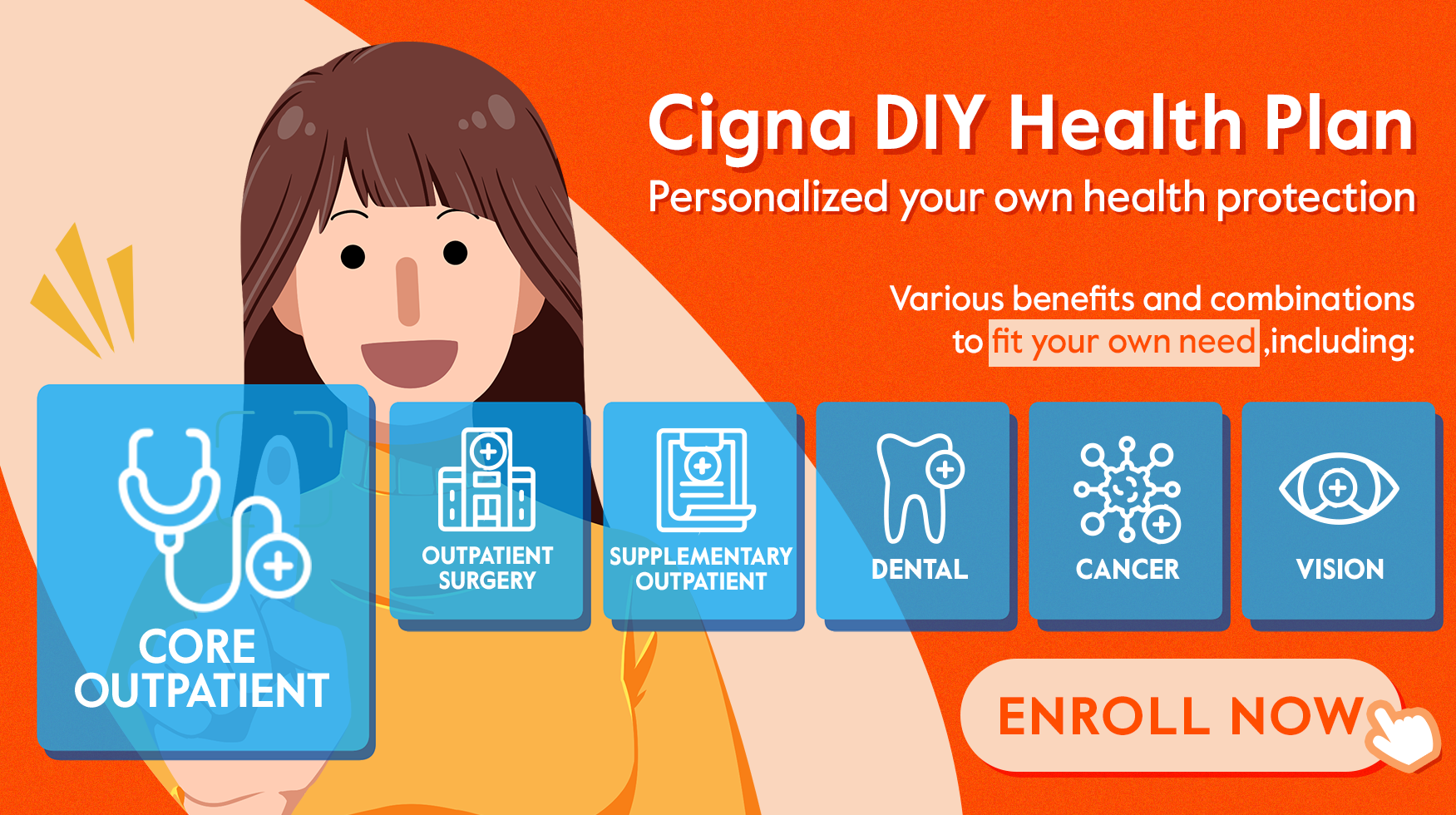Toothache is killing many of us. There can be numerous dental issues in one’s life, namely, Tooth decay, periodontal disease, periodontitis, gum bleeding, wisdom teeth, gingivitis, etc. In this article, Cigna Smart Health introduces one of the most painful dental illness - periodontal diseases by explaining its causes, treatment, prevention tips and the Modified Bass Tooth Brushing Technique. Let’s reclaim our healthy and white teeth together!
Understand the Tooth Structure
The average size of a human tooth is around 1.9-2.3 cm. The crown and gum, which you can see from the mirror, are only the upper part of the tooth structure. The reason why teeth can stand firmly depends on the support of the tissues around the teeth, including the gums, periodontal ligament and alveolar bone etc.
What is Periodontal Disease and How Do I Know I Have It?
When the periodontal tissues are infected by bacteria, Plaque forms on your teeth and accumulates, leading to periodontal disease. According to the degree of infection, periodontal disease can be divided into three stages.
Symptoms of Periodontal Disease by Stages
The levels of gingival and alveolar bone recession indicate the severity of the periodontal disease. Different stages of periodontal disease have varying symptoms, as shown below.
| Severity |
Stage |
Cause and Situation |
Percentage of gingival recession |
Area of gingival recession |
Symptoms |
| 1 |
Gingivitis |
Dental plaque accumulates since the teeth are not clean thoroughly. The plaque leads to gum inflammation (gingivitis). The plaque is calcified by saliva to form calculus or tartars. The rough surface of calculus accumulates more plaque and sustains the inflammation, making it more severe. |
<15% |
1-2mm |
Red and swollen gum, gum bleeding and bad breath |
| 2 |
Periodontitis |
The inflammation continues. Your gums recede or pull away from your teeth, and small pockets (periodontal pockets) form between gums and teeth. Food residue, plaque and calculus accumulates in the pocket, destroys periodontal tissues and leads to more severe inflammation. The gum and alveolar bone shrink gradually, exposing the tooth root. |
15%-33% |
3-4mm |
gum recession, exposed root surfaces, Tooth abscess, teeth sensitive when taking hot, and cold food, chewing difficult and inefficient |
| 3 |
Severe Periodontitis |
Periodontitis worsens and destructs periodontal tissues. Teeth may lose support, become loose and even fall off. |
>50% |
5mm or above |
loosening, drifting or even loss of affected teeth |
Sources: Healthline, iHealth
High-Risk Groups of Periodontal Disease
According to Dr. Tse Dat Chu (Specialist in Periodontology) from HKSH, poor oral hygiene is a major cause of periodontal disease.
Factors, such as genetics and family history of serious periodontal disease, also raise periodontal disease risk. Individuals with such traits and family history are more prone to the disease even though they maintain a good level of oral hygiene.
Other risk factors of periodontal disease include:
Treatments of Periodontal Disease
Having a high level of oral hygiene to lower the bacterial growth in the mouth can help mild cases recover and self-heal from periodontal disease. Below are some simple tips to protect your teeth.
- Brush your teeth and floss every morning and night
- Brush your teeth after every meal, ideally
- Pay a visit to your dentist and receive oral examinations regularly
- Scale your teeth once or twice a year to remove plaque and tartars
- Quit smoking
If your condition worsens, you may need to receive local anesthesia and further treatments, such as periodontal surgery and alveolar bone regeneration therapy. If your gum is clean without any inflammation, your condition can be considered as stable. You are then advised to have a regular follow-up consultation with your dentist to keep your condition on track.
The following are the fees for treating periodontal disease regarding the charges of some local dental clinics.
The Prince Philip Dental Hospital
| Items |
Fees for Treating Periodontal Disease (HKD)* |
| Periodontal Surgery |
$5,200 - $10,000 |
| Periodontal Regenerative Surgery |
$5,000 - $15,000 |
| Non-surgical Periodontal Therapy (per quadrant) |
$3,000 - $8,000 |
Institute for Advanced Dentistry Multi-Specialty Clinic of HKU Dentistry
| Items |
Fees for Treating Periodontal Disease (HKD)* |
| Periodontal Surgery |
$3,800 - $8,000 |
| Periodontal diagnosis and treatment plan |
$3,000 |
| Peri-implantitis treatment |
$3,800 - $7,000 |
*Prices as of 10 Apr 2021
Tooth Brushing with The Modified Bass Technique
Even though you brush your teeth every day, do you master the brushing technique? Let’s have a look at The Modified Bass Technique below and clean your teeth thoroughly every day and night!
- Step 1: Place your toothbrush at a 45-degree angle to your gum line (between your teeth and gum)
- Step 2: Move your toothbrush back and forth with short strokes (around 0.5cm) across two teeth at a time. Repeat this motion 8 to 10 times for every tooth.
- Step 3: Brush your teeth with a gentle circular motion 5 to 6 times to clean the tooth edge and gum.
- Step 4: Maintain a 45-degree angle to brush the inner side of your teeth. When cleaning your front teeth’ inner side, you may need to hold your toothbrush in a vertical position.
- Step 5: Scrub on the biting surfaces of the teeth gently.
Please take notes that tooth brushing cannot clean the interdental spaces. Therefore, it is necessary to use dental floss to clean the gaps after brushing your teeth every day.
Which Toothpaste Can Prevent Periodontal Disease?
The Tooth Club of the Department of Health suggests using toothpaste that contains fluoride to brush your teeth since it has been shown to prevent tooth decay for more than 100 years effectively.
Toothpaste with triclosan and zinc citrate can stop the accumulation of dental plaque and therefore prevent periodontal disease. Pyrophosphate and zinc citrate containing toothpaste can lower the rate of tartar formation.
Can Mouthwash Replace Tooth Brushing?
Mouthwash cannot replace brushing your teeth or flossing in terms of oral hygiene since it cannot effectively remove plaque accumulated on your teeth. In order for mouthwash to do your mouth any good, you should choose an oral rinse containing sodium fluoride and use it correctly.
If the concentration of the mouthwash is around 0.05%, you could rinse your mouth with it once a day. However, if it is too concentrated (around 0.2%), you should rather use it once a week.
Maintaining lifelong oral health requires daily effort. But you will thank yourself for not giving up when you still have a good set of teeth and good (oral) health at a later stage in life!
Are you looking for a medical insurance plan with dental coverage? Cigna DIY Health Plan enables you to freely choose from various protection benefits to customise your plan to your individual needs, including dental coverage, regular oral check-up, treatment cost and emergency. Tailor your health coverage now.
Sources:
© Cigna Healthcare 2023
Information provided in this article is intended for health and fitness purposes only and is not intended for use in the diagnosis of disease or other conditions, or in the cure, mitigation, treatment or prevention of disease (see Terms & Conditions for details). Any health-related information found in this article is available only for your interest and should not be treated as medical advice. Users should seek any medical advice from a physician, especially before self-diagnosing any ailment or embarking on any new lifestyle or exercise regime. Any information contained in this article may not be suitable, accurate, complete or reliable. Cigna Healthcare accepts no responsibility for the content or accuracy of information contained on external websites or resources, or for the security and safety of using them. "Cigna Healthcare" and the "Tree of Life" logo are registered trademarks of Cigna Intellectual Property, Inc. in the United States and elsewhere, licensed for use. All products and services are provided by or through operating subsidiaries, and not by The Cigna Group.




